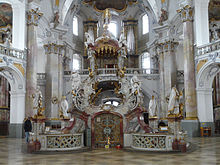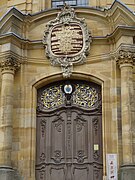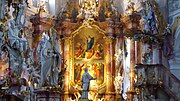Basilica of the Fourteen Saints
The Basilica of the Fourteen Saints near Bad Staffelstein in the district of Lichtenfels is a pilgrimage church in Upper Franconia . The church, built according to plans by Balthasar Neumann , is dedicated to the Fourteen Holy Helpers . It has about half a million visitors a year. In addition to the Basilica Marienweiher , the Bamberg Cathedral and the Basilica of Gößweinstein , the Basilica of the Fourteen Saints is the fourth minor basilica of the Archdiocese of Bamberg . The basilica is a defining part of what is known as the Garden of Godin the upper mainland .
General
- Location: on the upper Main between Bad Staffelstein and the district town of Lichtenfels ; Upper Mainland
- Built: 1743 to 1772
- Architect: Balthasar Neumann
- Style: Late Baroque facade; Interior design in Rococo style
- Rector of the Basilica: Father Maximilian Wagner OFM
- Diocese: Archdiocese of Bamberg
- Rank: Basilica minor (granted by Pope Leo XIII in 1897 )
- Cantor: Georg Hagel
- Height of the towers: 75 meters
Prehistory of the pilgrimage site
According to tradition, the baby Jesus appeared to the shepherd of the Langheim monastery in 1445 surrounded by other children, dressed half in red and half in white. These introduced themselves as the Fourteen Holy Helpers and requested that a chapel be built on the site. Then the crowd of children disappeared into the clouds. A few days after this miracle of the Frankenthal children's wreath, another miracle happened: A seriously ill maid was brought to the site of the apparitions, whereupon she recovered. A lively pilgrimage then began, encouraged by the granting of numerous indulgence privileges . The Langheim Cistercian Abbey quickly gave in to the urging of the faithful and built a chapel dedicated to the Fourteen Holy Helpers . In 1525, during the Peasants' War , it was reduced to rubble, but was later replaced by a larger church. The same happened after it was also destroyed in the Thirty Years' War .
History of the Basilica
In 1735, the Abbot of the Langheim Monastery , Stephan Mösinger , received permission from the Bishop of Bamberg, Friedrich Karl von Schönborn , to replace the old pilgrimage church with a representative new building. Several architects made designs for the construction, including the Weimar country master builder Gottfried Heinrich Krohne , who was chosen by Mösinger to build the church because of his way of building inexpensively but decoratively. However, this did not happen because the bishop vetoed it. In 1742, Balthasar Neumann was appointed to draw up a construction plan. The cornerstone of the church was laid in April 1743.
However, Neumann soon realized that Krohne, who was in charge of construction management, had deviated from the agreed plans and had moved the building a bit to the east. The altar could no longer stand as intended at the place of the apparition and sanctuary in the domed crossing . Contrary to liturgical custom, it was instead erected in the nave of the church. The bishop was of the opinion that this mistake was due to the fact that the Protestant Krohne was unfamiliar with the requirements of the Catholic pilgrimage. Another reason could be that Krohne wanted to keep the construction costs as low as possible, as requested by the abbot. Because if he had followed the plans, expensive leveling work would have been necessary. Be that as it may – the horrified bishop decreed: “All gamachten Lutheran by-jumps must be eliminated…” Neumann was commissioned to do the construction “completely in accordance with true Catholic requirements” (quoted from Schütz: Balthasar Neumann, p. 146 f.) . The electoral Mainz and Bamberg chief building director Maximilian von Welsch , himself a talented architect, suggested assigning the already standing walls to the choir alone : according to his plans, the church would have been 100 meters long and 80 meters high and would have been the size of almost all German churches surpassed baroque. But Welsch could not assert himself with these huge dimensions. Since tearing down the outer walls in the eastern part, which had already been completed, was out of the question for Neumann, in 1744 he prepared a building plan for a church based on the existing structure, which was to do justice to its task as a pilgrimage church and worthy shrine to the altar of mercy. However, this also meant that the altar remained in the nave. According to the original plan, the latter should traditionally only lead visitors to the spatial highlight in the domed crossing. Neumann remained in charge of construction until his death in 1753. He could not completely finish the church, but the vault was essentially his work. A pupil of Neumann, Johann Thomas Nißler , completed the building in 1772; on September 14, 1772 it was consecrated by the Bamberg Prince Bishop Adam Friedrich von Seinsheim .
The first half of the 19th century was a difficult time for the Basilica of the Fourteen Saints: After the secularisation that had taken place in Bavaria in 1803, the Cistercians who had been in charge of the pilgrimages not only had to leave Langheim Monastery , but also the provost in Fourteen Saints. Church treasures were squandered, altarpieces disappeared without a trace. Part of the organ which was very valuable and the bells were sold to the highest bidder. Pilgrimages were forbidden by the church and state at this time.
In 1835 the organ, the roof truss and the two towers burned down after a lightning strike in Vierzehnheiligen. The church looked like a ruin. It was not until 1839 that King Ludwig I of Bavaria commissioned the Franciscans of the Bavarian Franciscan Province to oversee the pilgrimage. They also restored the church. The renovated church corresponded to the taste of the time: the steeples had been redesigned, the new Bittner organ covered four windows in the west gallery and the interior design also differed from Neumann's plans in other details.
In 1897, Pope Leo XIII. The Fourteen Saints is the second German church to have the rank of a minor basilica . The other was the Basilica of Our Lady in Alsace, now in France . Further renovations followed in the course of the 20th century, returning to Balthasar Neumann's plans . Nothing was changed during the most recent renovation at the end of the 20th century. The new Rieger organ from 1999 now only covers one window, so that the rococo architecture comes into its own again.
Architecture of the Basilica
The outside view is characterized by the representative facade with the elegantly protruding middle part and the two high towers. The appearance is designed with its proportions for a long-distance view and represents an answer to the facade of the church of the Banz monastery on the opposite slope , on which it is partially based in the structure. The facade is considered one of the most imposing of the Baroque era.
The design of the building was influenced by the problems described above due to its eastward shift. Nevertheless, Neumann managed to design the interior completely independently of the outer walls: With several overlapping ovals, he ensured a dynamically curved floor plan that made the entire interior very lively. Around the altar, gently embracing it as it were, is a so-called large grace oval, detached from the structure of the outside, which aligns the entire room with the place of the apparition and gives it a stately touch with its colossal three-quarter columns.
The fine stucco work by Franz Xaver Feuchtmayer , Johann Michael Feuchtmayer the Younger and Johann Georg Üblhör , the paintings by Giuseppe Appiani and last but not least the altar of grace bear witness to the primary influence of the Rococo spirit on the sacred building . The light falling indirectly through many windows contributes to the special atmosphere of the room.
Construction of the vault began only after Neumann's death. The fact that it was nevertheless completed is thanks to the Staffelstein master builder Thomas Nißler. It is undoubtedly a feat of engineering, largely because Neumann could not calculate everything precisely in advance and Nißler had to rely solely on his experience. The wall was supposed to be twelve centimeters thick and made of Franconian limestone marble , a material that wasn't particularly strong. When the basilica was built, no one believed that it would last. Yet it withstood all the weather and even the devastating church fire of 1835 (the basilica had no roof for only two years after the fire).
Furnishing
One enters the basilica at the end of the north transept. The western main portal is usually only open during heavily attended services. There you will be greeted by the Eisenbarth choir organ and, during the Christmas season, by the large crib in the south transept . In its center, the basilica is dominated on the left by the high altar. On the right is the heart, the altar of grace, a Rococo masterpiece. The mighty Rieger organ dominates the picture on the high west gallery .
altar of grace
The rococo altar with the Fourteen Holy Helpers stands freely in the middle of the nave and is surrounded by a curved communion lattice . The view of the site of the apparition opens up to the side. The lower part of the altar, decorated with stucco marble, is vaulted by a permeable canopy made of sparkling rocailles , which keeps the view of the high altar clear. Twelve of the Fourteen Holy Helpers are attached to the altar of grace, aligned to the four cardinal points, on three floors one above the other. Barbara and Katharina stand at the two side altars.
The Fourteen Holy Helpers include 3 bishops ( Dionysius , Erasmus , Blasius ), 3 martyrs ( Barbara , Margareta , Katharina ), 3 knights ( George , Achatius , Eustachius ), the doctor Pantaleon , the monk Aegidius , the deacon Cyriacus , a boy ( Vitus ) and 1 Christ child bearer ( Christophorus ).
Small selection of the 14 depictions of the Holy Helpers:
organs
Already in the 18th century there were two organs in Vierzehnheiligen. One stood on the gallery above the sacristy, the other, larger, on the west gallery. Over time, organs by Augustin Ferdinand Bittner from Nuremberg and Ludwig Weineck from Bayreuth were in the basilica. In 1905 the Steinmeyer company expanded the existing organ. Your work was renewed again in 1951 by Steinmeyer.
After the renovation of the church was completed, the damaged organ was also replaced. In 1999, the Austrian company Rieger Orgelbau produced a new instrument with 68 sounding registers based on the concept of a universal organ . It consists of a Hauptwerk (I), a Positive (II), a French Swell (III) and a Chamade (Bombard, IV). For the disposition of this organ see here .
In the south transept of the basilica there is a mobile two-manual choir organ by Eisenbarth .
bells
The first big peal of the church had already been completed when it was inaugurated in 1772 and included six bells, which were cast by the bell founder Johann Andreas Mayer from Coburg. In the course of secularization, the three largest bells had to be removed from the tower and sold after only 30 years, but were initially preserved in the parish church in Lichtenfels. The basilica now only had the three small bells. However, the devastating fire in March 1835 destroyed both the towers and the bells. A new bell was soon cast by the Bamberg bell founder Georg Michael Keller, but it was not sufficient for the rank of the important church building. The two large bells were finally commissioned from the Lotter bell foundry in Bamberg in 1869 and have formed a worthy foundation for the bells to this day. However, the First World War and the associated bell acceptance meant the end for the three cellar bells from 1839 - they were melted down. After the end of the war, the Ulrich bell foundry in Apolda cast three new bells in 1921 and filled the gap in the ringing caused by the war. During the Second World War, the existing bells (with the exception of the Blasius bell) had to be confiscated and were returned after the end of the war. Only the Nothelferbell never returned and was replaced in 1950 by the Landshut bell foundry Hahn
In the 1980s, the five bells were hung on cranked steel yokes to reduce the load on the towers, which, however, was associated with a reduction in the sound. It also turned out that the technique of the new suspension caused damage to the bells, which is why the three smaller bells in the north tower were hung on straight yokes again. After two crown handles broke and the Georgsglocke threatened to fall, the ringing in the south tower was stopped. The belfry will be renewed as part of major renovations, which are due to be completed in 2022.
In order to relieve the historical bells, six new bells were commissioned in 2019. These were consecrated on September 8, 2019 and rang out for the first time on November 24, on Christ the King Sunday. Four of the new bells are cymbal bells and form the crowning sound of the ringing (bells 8-11). The two other sound bodies complement the tone sequence of the existing bells.
| No. |
Surname |
casting year |
caster, casting place | diameter (mm) | mass (kg) | Strike Tone ( HT - 1 / 16 ) |
inscription |
|---|---|---|---|---|---|---|---|
| 1 | george | 1869 | Lotter, Bamberg | 1662 | ~2900 | h 0 +1 | |
| 2 | Blaise | 1869 | 1387 | ~1700 | d1−2 _ _ | ||
| 3 | Maria | 1950 | Hahn , Landshut | 1100 | ~1100 | e 1 −1 | |
| 4 | De Profundis | 1921 | Ulrich , Apolda | 1089 | ~750 | f sharp 1 −5 | |
| 5 | Bernard and Benedict | 2019 | Bachert , Neunkirchen (Baden) | 1045 | 702 | g 1 +1 | SAINT BENEDICT - WHAT IS BETTER THAN THE VOICE OF THE LORD WHO INVITES US SAINT BERNHARD - OPEN YOUR HEART'S EAR |
| 6 | Fourteen Holy Helpers | 1921 | Ulrich , Apolda | 894 | ~450 | a 1 +5 | |
| 7 | Francis | 2019 | Bachert , Neunkirchen (Baden) | 870 | 449 | h1 + 1 | SUPREME GLORIOUS GOD, ENLIGHTEN THE DARK THINGS OF MY HEART AND GIVE ME RIGHT BELIEF, SECURE HOPE AND PERFECT LOVE. |
| 8th | Regina Coeli | 2019 | 656 | 204 | e 2 +4 | REGINA COELI LAETARE QUIA QUEM MERUISTI PORTARE RESURREXIT SICUT DIXIT + + ORA PRO NOBIS DEUM + HALLELUJA (Rejoice, Queen of Heaven, whom You were worthy to bear, He has risen as He said. Pray to God for us, Hallelujah) |
|
| 9 | Domina Angelorum (Queen of Angels) | 2019 | 580 | 136 | f sharp 2 +1 | AVE REGINA COELORUM AVE DOMINA ANGELORUM SALVE RADIX SALVE PORTA EX QUA MUNIDO LUX EST ORTA (Hail, Queen of Heaven, Hail, Lady of Angels, Hail, root from which salvation sprouted, door that opened the light to us.) |
|
| 10 | Stella Maris | 2019 | 553 | 118 | g 2 +1 | AVE MARIS STELLA DEI MATER ALMA ATQUE SEMPER VIRGO FELIX COELI PORTA (Star of the sea I salute you, exalted Mother of the Lord, ever virgin, happy gate of heaven) |
|
| 11 | Puer Natus Est (A child is born to us) | 2019 | 487 | 82 | a 2 +2 | PUER NATUS EST NOBIS et FILIUS DATUS EST NOBIS (A child is born to us, a son is given to us.) |
Others
The Franconian Marienweg runs past the Basilica of the Fourteen Saints.
See also
literature
- Günter Dippold and Andreas Bornschlegel: Basilica of the Fourteen Saints. Bad Staffelstein 1992, ISBN 3-9801257-4-2
- Wilfried Hansmann: Balthasar Neumann. 2nd edition, Cologne 2003
- Bernhard Schütz: Balthasar Neumann. 2nd edition, Freiburg i.Br. 1986
- Christoph Glatter-Götz and others: The organ of the Basilica of the Fourteen Holy Helpers , ISBN 3-9804630-5-2
web links
- Site of the Basilica of the Fourteen Holy Helpers
- Fourteen Saints on the website of the German Franciscan Province
- Basilica of the Fourteen Saints project at the Meranier-Gymnasium Lichtenfels
itemizations
- ↑ Website of the Basilica of the Fourteen Saints: History of the Pilgrimage ( Memento of March 5, 2013 in the Internet Archive )
- ↑ Ben Schröder: Fourteen Holy Helpers (STE) The eleven new bells of the pilgrimage basilica of the 14th Nothelfer (tower shot). Retrieved December 22, 2019 .
- ↑ Website of the Basilica of the Fourteen Saints: The bells are silent. Retrieved October 6, 2019 .
- ↑ Website of the Basilica of the Fourteen Saints: The new bells. Retrieved October 6, 2019 .
- ↑ Website of the Basilica of the Fourteen Saints: removal of the bells. Retrieved October 6, 2019 .
- ↑ On the inscriptions of the new bells
Coordinates: 50° 6′ 56″ N , 11° 3′ 16″ E















